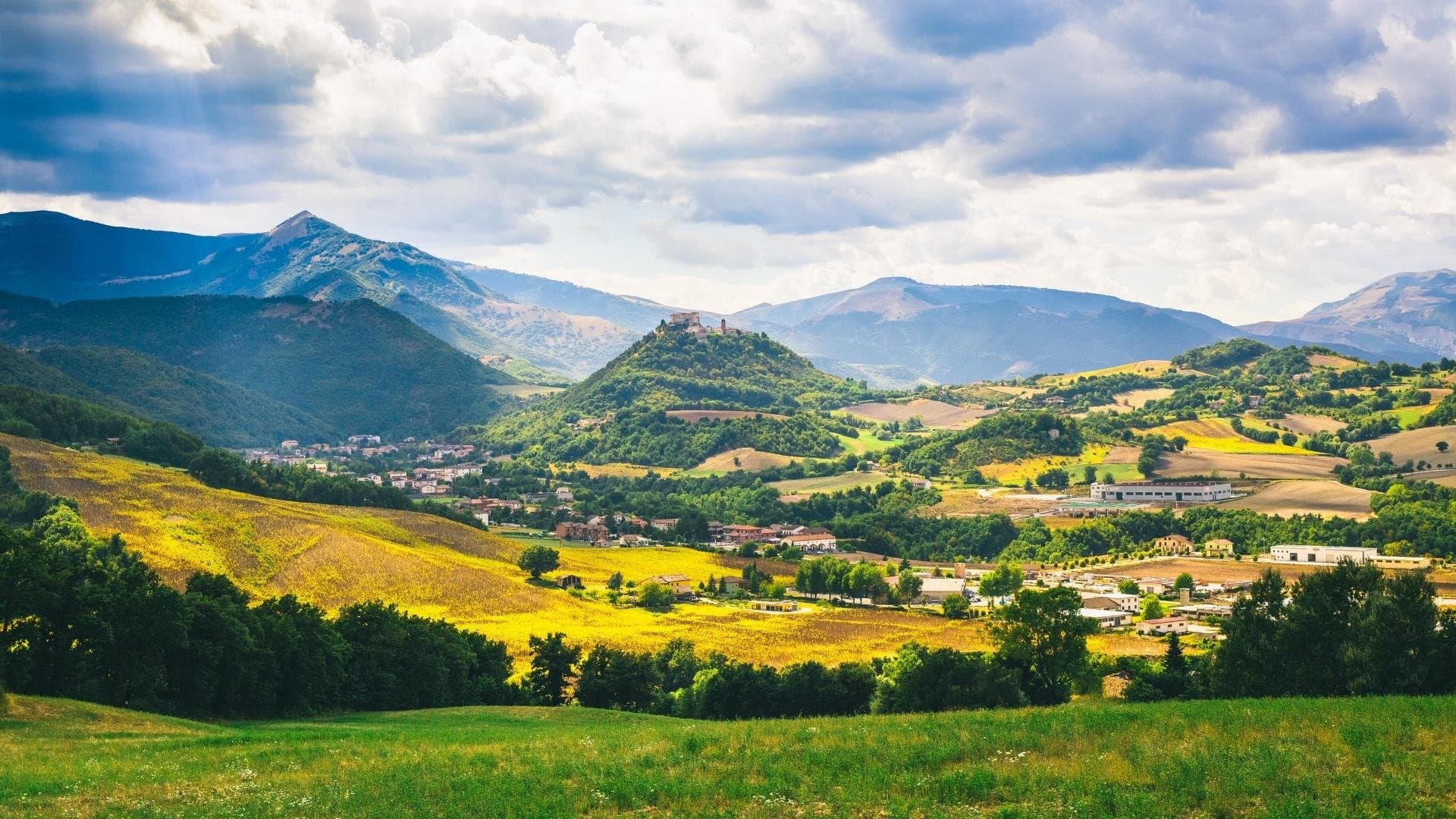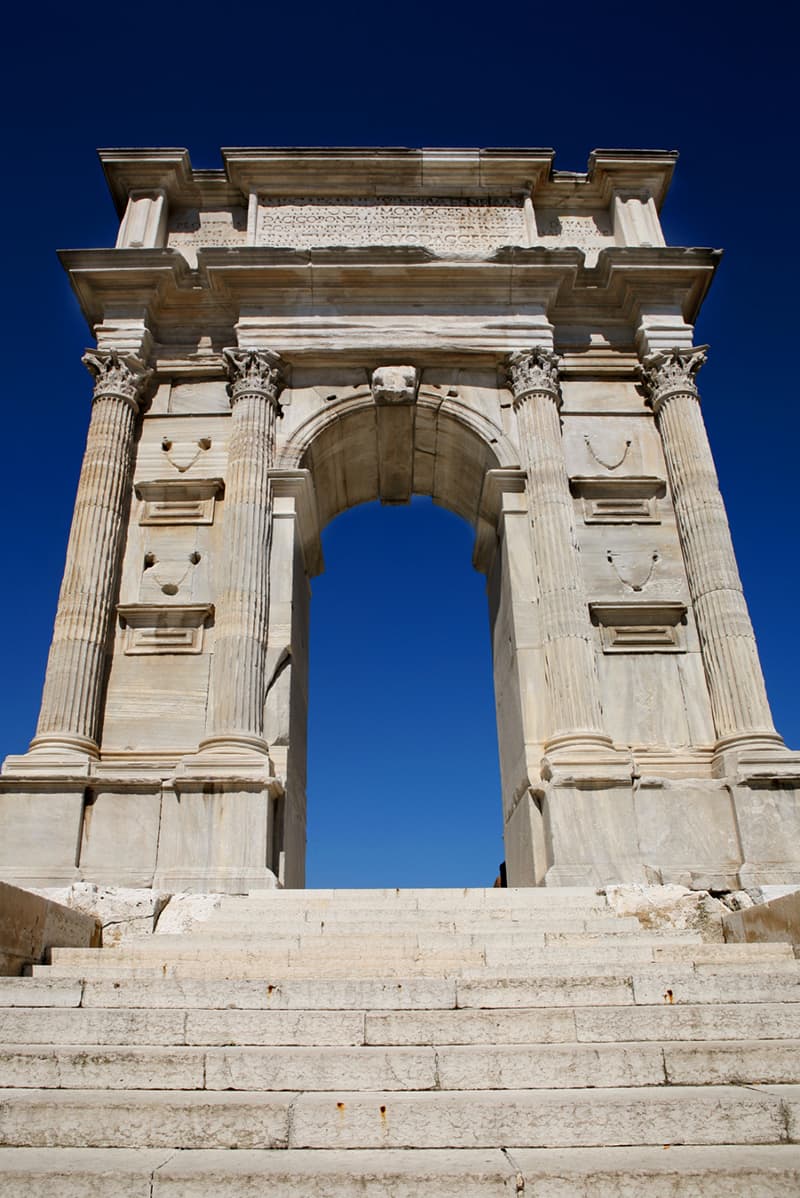The territory of Marche, located between Umbria - Marche Apennines and the Adriatic Sea, is characterized by a mainly mountainous and hilly landscape, whereas plains stretch along the coastal area. The Sibilini Mountains, straddling the borders among the provinces of Macerata, Fermo and Ascoli Piceno, are the highest mountain range in the area and they can be considered the cradle of myths and legends.
On the shore, you can admire the majestic promontory of Mount Conero, which spreads from Ancona to Numana and that represents the pearl of the Adriatic Sea: it offers evocative landscapes, made up of luxuriant greenery, magnificent beaches, picturesque bays, lapped by crystal-clear waters.
Italian writer and journalist Guido Piovene has coined the expression "Marche the only zone in Italy with a plural name" in his literary guide Journey to Italy to highlight the distinctive feature of this heterogeneous geographical area from the panoramic point of view, shaped by various cultural influences.
Follow us in this reading to find out about the main sights and the range of opportunities offered by this charming territory.

5. Intellectuals and artistic masterpieces of Marche Region
Marche Region can be regarded full-fledged as a widespread museum thanks to its magnificent cities of art and its medieval ancient villages, nestled as gems in a bucolic landscape.
This land has been the birthplace of artists, scholars and well-known exponents of worldwide cultural landscape, like Giacomo Leopardi, one of the most important intellectuals and poets of Italian 19th century, the opera composer Gioacchino Rossini, the tenor and actor Beniamino Gigli, Donato Bramante, painter and innovator of the Italian architecture of the 16th century, Raffaello Sanzio, celebrated artist native of Urbino and Maria Montessori: it preserves artistic masterpieces carried out by Gentile da Fabriano, Lorenzo Lotto, Tiziano, Rubens, Giusto di Gand, Piero della Francesca and a very rich and remarkable archaeological heritage, dating back to Picene, Greek and Roman age.
If you need some inspiration, we suggest you to visit Castelfidardo, an evocative village, that overlooks the fertile Musone valley. It's well-known worldwide for the production of handmade accordions.
Carrying on with our tour and setting off at the discovery of some of most picturesque and magnificent places of this region, we arrive at Corinaldo, a precious gem in the hinterland of Senigallia, that is located over the brow of the hill. It has been awarded the title of "one of the most beautiful villages in Italy" and of Orange Flag village.
Here you will be able to admire the ancient and majestic city walls, which date back to 1400 and the Piaggia: if you follow one of peculiar alleys that branch off from it, you can visit the Scuretto's House, one of the symbols of Corinaldo, and the so-called Polenta Well.
Moreover we suggest you to visit some of the prestigious historic buildings, such as Carlo Goldoni Theatre, decorated with exquisite elements of plaster, and the City Hall, carried out in neoclassical style by architect Francesco Maria Ciarrafoni.
In addition Offida, pearl of the Marche Region, is an ancient Medieval village, located on a spur of rocks between Tesino and Tronto valley and nestled in castle walls built in the 15th century.
It's a world-famous place for traditional art of making bobbin lace and for re-enactments, connected to famous historical Carnival, one of the most spectacular events of Italian peninsula.
4. History and traditions
History of this zone, melting pot of different civilizations, cultures and traditions since forever, "Italian gateway to the East”, is very particular since it shows influences of various people who have followed one another throughout the millennia.
Starting from Iron Age Picenes, who came into contact with Etruscan civilization and with Magna Graecia culture, settled there: establishment of Ancona colony dates back to that epoch. Then the Gallic Senones have occupied the area at the North of Esino river.
Following the expansion of the Roman Empire there were continuous exchanges between Italic people and the conquerors even on account of the construction of the Via Flaminia and the Via Salaria. The subsequent arrival of Byzantine people, of Roman Barbarian kingdoms and of the Langobards has contributed to shape the hereogeneous and multicultural identity of Marche Region.
Furthermore, we point out a curiosity: the portrayal of the woodpecker in the regional emblem should be explained with the fact that, according to tradition, the Sabines, left from Lazio in the 9th century BC, would have reached the Adriatic coastline proceeding with the flight of a bird.
3. What to see and what to do in Marche Region: naturalistic tours
As regards itineraries and tours you can undertake to discover this charming region, they are very numerous, from hiking to pilgrimages and simple walks. Thus the lovers of unpolluted natural environment and of wilderness can go for a hike and visit National Parks of Gran Sasso, Laga and Sibillini Mountains or venture into the fairy-tale landscape of Frasassi caves, sprinkled with stalactites and stalagmites.
2. Cultural itineraries
If you are an art enthusiast, you can visit enticing cities, rich in history, culture and traditions, that shield precious masterpieces. First of all Ascoli Piceno will receive you with its elegant and harmonic old town built with travertine and with a perspective game of the buildings that overlook Piazza del Popolo, whereas medieval hamlet of Cupra Marittima will enchant you with intense fragrance of its centuries-old pines.
Fermo preserves its ancient roman cisterns and its cultural treasures, whereas patrician Macerata is the location of a prestigious university, founded in 1290, and of Sphaeristerium.
Osimo, encircled by majestic Roman walls, preserves its magical and mysterious underground city, dug 2500 years ago; Ancona, founded by Syracusan Dorian people in 387 BC, is enriched by artistic masterpieces, dating back to different ages, such as Arch of Traiano.
Proceeding towards the interior, travellers can admire the ancient village of Jesi, with its magnificent castles and its grandiose walls, where you can taste a suggestive Medieval atmosphere. Jesi has been honoured by Unesco with the title of "exemplary city" because of the diligence it has demonstrated in the preservation of its historic, artistic and cultural heritage.
Moreover, Pesaro is another cultural city, that boasts its untouched Roman monuments, whereas Urbino, World Heritage Site, has been the cradle of the Court of Federico da Montefeltro.
1. Typical products of the Marche Region gastronomy
The gastronomic tradition of the Marche Region is very varied and it merges refined typical recipes of coastal area with rustic and simple flavours of mountain and hilly dishes. Acqualagna truffle, Ciauscolo, Carpegna and Montefeltro ham, fried Ascolana olives, Monte Rinaldo pecorino cheese and sweets, mainly made with dried fruit, stand out among regional delicacy, whereas brodetto is renowned on the seaboard and its preparation changes according to local habits.
Viticulture production stands out among enogastronomic delicacies and you can taste some wine in pairing with typical dishes: enjoy a moment of relaxation at the table, in moderation, with a glass of one of the renowned local wine varieties, such as Sangiovese, Verdicchio, Trebbiano and Montepulciano.
About the author
Written on 25/05/2022








Simone Pini
Are you fond of nature, history, ancient villages, art and local folklore? Discover Marche Region, enchanting land rich in treasures and typicalities.